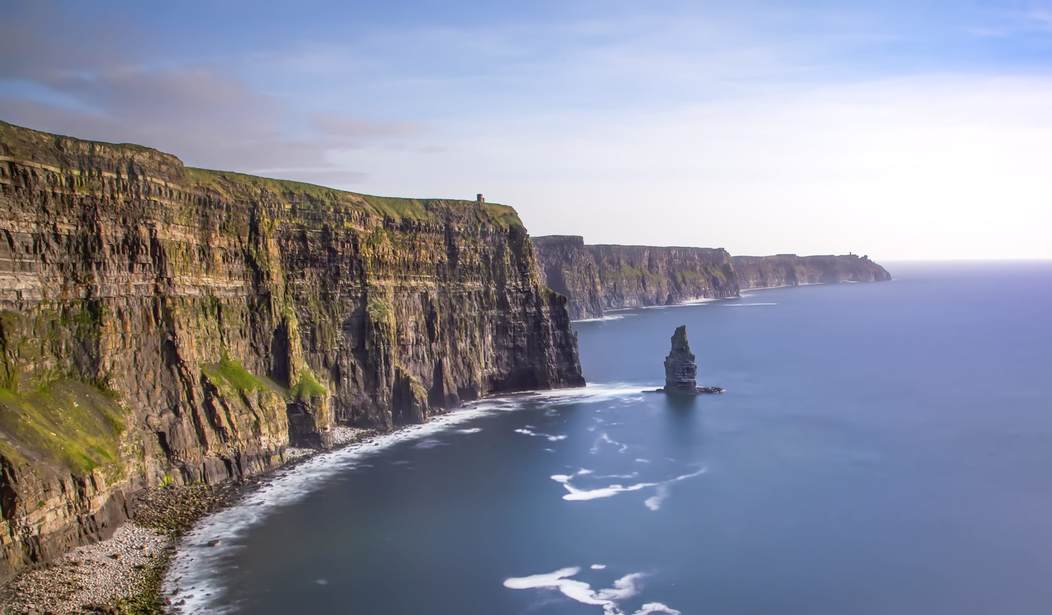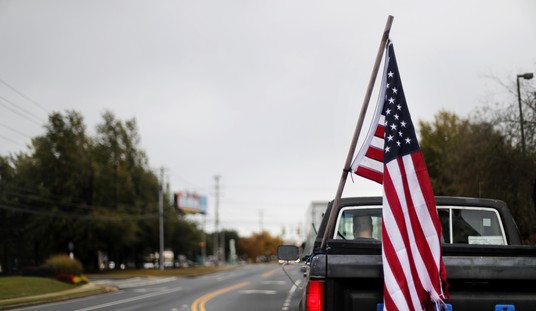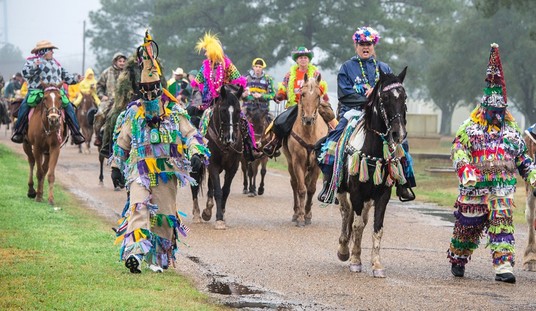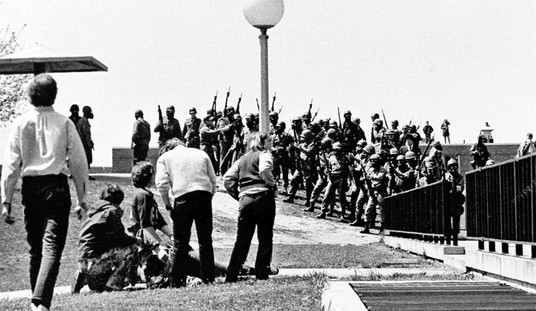Yesterday was St. Patrick’s Day here in Ireland, and around the world as well. (Did you know that Patrick is the patron saint of Nigeria? I didn’t, until my parish priest here in rural County Clare informed us of that during his homily.) In places like New York and Boston, it’s a day to celebrate Irish heritage and to get disgracefully drunk, but not in Ireland, where it’s also a national holiday; until the 1960s, it was illegal to sell alcohol on Patrick’s Day, as it also was to sell booze on Christmas Day and Good Friday. Further, the drunk-driving laws here are now very strict, and the Irish police, know as the Guards, let it be known there would be sobriety checkpoints and random stops all over the country, not only yesterday but today as well, when the holiday is being observed.
As it happened, yesterday was freezing cold and blustery here in the West, hard by the famous Cliffs of Moher, which didn’t stop the surrounding towns and villages from holding their parades. As the days lengthen, the tourists are now starting to show up, so the streets and pubs had plenty of American accents. Young Americans are surprised to discover that the Irish don’t get smashed on St. Patrick’s Day, of course, but even more shocked to learn that they stay pretty sober in the pubs the rest of the year as well. This is not necessarily so in Dublin and the other cities, where public transportation is good and cabs are plentiful. But in the countryside, you generally have to drive to get to your local and in all my years of coming home to Ireland, I’ve never seen a local man cause a scene, pick a fight, or stagger to his car.
Ireland is changing in other ways as well. Gay marriage (we have a gay Taoiseach, or prime minister) is in, and so is abortion. Not surprisingly, a country that used to be known for its strong Catholic faith was, in the wake of the homosexual priest molestation scandals around the world, was only too happy to throw off what it considers its embarrassing old morality and embrace the fashionable social and sexual progressivism of Europe. And now the Permanent Bipartisan Fusion Party that controls both Irish politics and the national media has decreed that Ireland (pop. 5 million or so), a former net exporter of people, will need to import upwards of one million people by 2040.
But that’s still in the future. Having joined the EU against its will, Ireland has now come to embrace the enervated “modernity” of France and Germany; it’s like watching a child parading around in its grandfather’s tie-dyed bell bottoms and thinking he’s now a sophisticated grownup. For along with the new highways and the coercive monetary and agricultural policies has also come some of the fashionable nihilism of the Europeans, who can’t be bothered to replace themselves and so are franchising out the jobs they just won’t do any more, and the taxes that somebody will have to pay in order to keep the senescent comfortable in their dotage before they collectively take the Big Sleep. Whether that will happen here as well remains to be seen — the Irish have certainly proven their resilience over the millennia — but for Ireland to stay Ireland, the core of the country needs to hold fast. Alas, it’s not.
In a column about the meaning of St. Patrick (who wasn’t himself Irish, but rather a Romanized Briton), Father George Rutler, the past of St. Michael the Archangel Church in New York City, has some interesting observations, not the least of which is that Patrick was a contemporary of another pillar of the Church, St. Augustine of Hippo:
The holy patron of our archdiocese was a contemporary of St. Augustine. While Augustine of north Africa became one of the greatest Doctors of the church, Patrick of Roman Britain humbly called himself uneducated, even though he was schooled in France by St. Germaine of Auxerre and possibly St. Martin of Tours, and was given books by Pope St. Celestine I.
Augustine’s diocese essentially no longer exists: Hippo lies in present-day Algeria. It first fell to the Vandals, then was reconquered by the Byzantines of the eastern Roman Empire, and finally was overrun by Arab Muslims in 698 A.D.
Patrick, after six youthful years as a slave captured by Irish pirates, embarked upon the conversion of the Druid tribes. He did not chase the snakes out of Ireland because there were none, nor did he explain the Holy Trinity using a shamrock, for that would have been a Partialist error inconsistent with the Niceno-Constantinopolitan Creed formulated just a few years before his birth. But he sparked a fire that spread the Gospel light to many parts of the world. The largest number of people who claim Patrick for their patron are Nigerians, converted by heroic Irish missionaries. The number of baptized Catholics in Nigeria has soared from 19 million in 2005 to 53 million today.
But as the Church grows elsewhere, especially in sub-Saharan Africa, it declines in the lands where Augustine and Patrick once preached, and paganism, in form of everything from Islam to neo-Druidism to Euro-atheism, waxes accordingly:
In contrast, despite many worthy witnesses, the majority of Irish people failed to heed the warnings of St. John Paul II when he became the first pontiff to set foot on the soil of Eire. He preached to 1.25 million faithful at a Mass in Phoenix Park, Dublin. Last year, Pope Francis offered Holy Mass in the same place, and fewer than 130,000 showed up. Four months later, the Druids returned and defiantly danced in the streets when abortion was legalized. The Taoiseach (Prime Minister) was elected while publicly living in perverse contempt of the sacrament of Holy Matrimony. The chief seminary of Maynooth has the lowest numbers of students since its foundation in 1795. Its rector of 15 years abandoned the Faith and now conducts an esoteric cult in Arizona. An Irish commentator and playwright recently called Ireland “The Most Anti-Catholic Country on Planet Earth.”
From the Easter Rising of 1916 to the vassalage of the European Union less than a century later — perhaps the 800 years of subjugation to England was too much from the ones who stayed behind, and rushed from one form of tyranny into another with barely a pause. But the revolutionary spirit lives on elsewhere today, not only in the lands of emigration (the U.S., Canada, Australia, New Zealand, the U.K.) but in places converted by the spirit and meaning of Patrick’s message:
The St. Patrick’s Day parade in New York City has become a bibulous charade of St. Patrick. While contingents advertise their contempt for his Gospel, Nigerians honor St. Patrick in a different way. A few weeks ago, Nigerian soldiers under attack by the Islamic terrorists Boko Haram, did not masquerade as leprechauns drinking green beer. In a Zamiza forest, they knelt and chanted as their chaplain raised aloft for adoration the same Blessed Sacrament with which Patrick had faced the Druids.
Perhaps the faith was outmoded, not up to the snuff of Juncker and Macron and Merkel. But through the Dark Ages that followed the final collapse of the western Roman Empire in 476, it was the Irish monks who kept as much of classical learning and artifacts alive as they could for as long as they could — it’s painful to think of what treasures were destroyed when Henry VIII ordered the sacking of the monasteries in a fit of pique. Betrayed by their bishops, as all Catholics have been, and saddled with a pope who inspires no affection and precious little respect, the Irish have resorted to a national characteristic that served them so well during the Penal Laws and other British enormities: they have simply turned their back on the Church and ignore it.








Join the conversation as a VIP Member